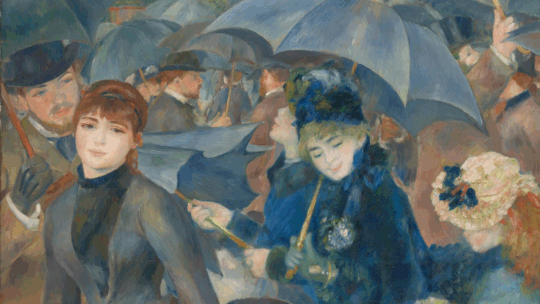They say every work is a piece of art, so what happens when you throw in an umbrella?
Whether it’s brushstrokes or budgets, the right umbrella brings structure, flow, and a sense of calm when needed most.
We reimagined some of the most iconic umbrella-filled artworks through the lens of cloud cost management. Because when visibility, precision, and balance come together, FinOps becomes more than just operational; it becomes an artfully done process.
Monet’s Woman with a Parasol: Bringing Lightness to Cloud Sustainability

Image: Woman with a Parasol – Madame Monet and Her Son, Claude Monet, 1875. Courtesy National Gallery of Art, Washington. Public domain, CC0 license.
Claude Monet’s Woman with a Parasol – Madame Monet and Her Son (1875) captures a quiet afternoon walk in the French countryside. The scene is full of motion, light, and openness—an impression of harmony with the natural world.
It’s a gentle cue that the environments we move through should be preserved with care.
As cloud infrastructure grows, so does its environmental footprint. Every workload draws energy. Every region consumes water. And every optimization decision impacts more than just spend.
That’s why GreenOps is gaining momentum, the FinOps sustainable approach that brings environmental metrics into the same view as cost. When teams can view real-time data on emissions, energy usage, and cloud waste, sustainability becomes an integral part of everyday decision-making.
Because sustaining what’s beautiful, in art or nature, means making intentional choices about the footprints we leave behind (even in the cloud).
Renoir’s The Umbrellas: FinOps for Multi-Tier Complexity

Image: The Umbrellas, Pierre-Auguste Renoir, c. 1881–86. Courtesy The National Gallery, London. Public domain.
Pierre-Auguste Renoir’s The Umbrellas (c. 1881–86) depicts a crowded Paris street just after the rain. The canvas is filled with umbrellas, figures crossing paths, and overlapping directions, yet the scene feels in sync. It’s motion that’s organized and purposeful, with every part holding its place in the whole.
That’s the kind of coordination today’s cloud distributors are striving for.
Value-Added Distributors (VADs) operate at the center of multi-tier ecosystems, managing spend across Managed Service Providers (MSPs) and their end customers. There are layers of responsibility, complex billing relationships, and usage spread across multiple clouds.
To maintain alignment, distributors require clear visibility across every tier—and tools that support shared commitments, structured chargebacks, and automated rebilling. Without that, complexity gives way to chaos.
Because, like Renoir’s scene, when every part knows its place, no matter what the cloud brings, complexity becomes coordinated.
Seurat’s A Sunday Afternoon: Turning Fragmented Data into a Unified View

Image: A Sunday on La Grande Jatte — 1884, Georges Seurat, 1884–86. Courtesy The Art Institute of Chicago. Public domain.
Georges Seurat’s A Sunday Afternoon on the Island of La Grande Jatte (1884–86) is a masterpiece of pointillism (a painting made from thousands of small, deliberate dots). Each dot is small on its own, but together, they form a complete, recognizable picture.
It relates to a common theme of consolidating spend in FinOps.
Most organizations track costs across a mix of cloud providers, such as SaaS tools, finance systems, and spreadsheets. The challenge isn’t just having the data, it’s seeing it all in one place.
Bring Your Own Data (BYOD) strategies allow FinOps teams to pull in cost information from non-cloud-native sources and align it with existing cloud spend.
When cost data is organized in a single, structured view, decisions become clearer, collaboration becomes easier, and blind spots start to disappear.
Because what looks like chaos up close becomes clarity when it’s all part of the same picture.
Vettriano’s The Singing Butler: Shielding FinOps from Sudden Spikes

AI-generated reinterpretation of The Singing Butler by Jack Vettriano (1992). Original painting viewable via Wikipedia.
Jack Vettriano’s The Singing Butler (1992) shows a couple dancing on a windy beach while a butler and maid hold umbrellas over them. The sky is dark, the weather unpredictable, but the dancers stay composed, thanks to the quiet work of those shielding them from the storm.
In FinOps, “the dancers” are your teams (engineering, finance, and operations), focused on keeping the business in motion. “The storm” represents the unpredictable: sudden spend spikes, usage anomalies, tagging issues, or configuration changes that can disrupt everything.
And the ones holding the umbrellas? That’s anomaly detection.
When built into your workflow, anomaly detection quietly protects the team by flagging issues early, providing context, and allowing space to respond before things spiral out of control.
Because if you’re going to keep moving in the world of FinOps and cloud costs, you need an umbrella that shields you when sudden changes hit.
Hassam’s Rainy Day, Boston: Adapting to What the Cloud Brings

Image: Rainy Day, Boston, Childe Hassam, 1885. Courtesy Toledo Museum of Art. Public domain.
Childe Hassam’s Rainy Day, Boston (1885) shows a quiet city street on a rainy day. Just a few people walk through the scene, umbrellas up, calmly making their way through the wet conditions; their movement feels steady and deliberate.
Where Renoir captured the complexity of a busy crowd, Hassam offers a more intimate moment, one that reflects how well-designed FinOps practices can carry on, even when conditions shift.
In this scene, the people walking with umbrellas represent steady workflows (forecasting, reporting, and budgeting) that are built to adapt to changing conditions. The rain might symbolize cost spikes, new services, or shifting usage, but progress doesn’t stop.
That’s what FinOps in a multi-cloud world demands: structured, flexible processes that keep moving, no matter the weather.
Whether you’re managing spend in AWS, Azure, GCP, or beyond, staying responsive is key. It’s not about avoiding change. It’s about knowing how to adjust when it happens.
Because in FinOps, staying on track doesn’t always mean staying dry, it means being ready when the weather turns.
A Great Umbrella Belongs in FinOps and Art
Umbrellas in art do more than block the rain. They symbolize structure, awareness, and balance, no matter the environment.
At Umbrella, we built our platform to deliver the same: a dependable center in cloud cost, purpose-built for the complexity of modern FinOps.
Here’s how we help you bring your FinOps picture into focus:
- Add depth to your strategy with real-time GreenOps metrics that provide insights into carbon, water, and energy, without requiring you to switch dashboards.
- Fill in the missing pieces by uploading SaaS, internal, or legacy cost data into the same view as your native cloud spend.
- Zoom out on your ecosystem with Distributor Edition—purpose-built for VADs managing multiple layers of partners and customers.
- Spot irregularities fast, like brushstrokes that don’t belong—our anomaly detection highlights issues the moment they appear.
- Clean up cloud waste with workflows that make optimization feel like retouching, not rework.
- Sketch what’s ahead with forecasting tools that help you plan with confidence, even when the cloud landscape shifts.
Try Umbrella and see the complete picture of what your FinOps practice can become. Get in touch today!
